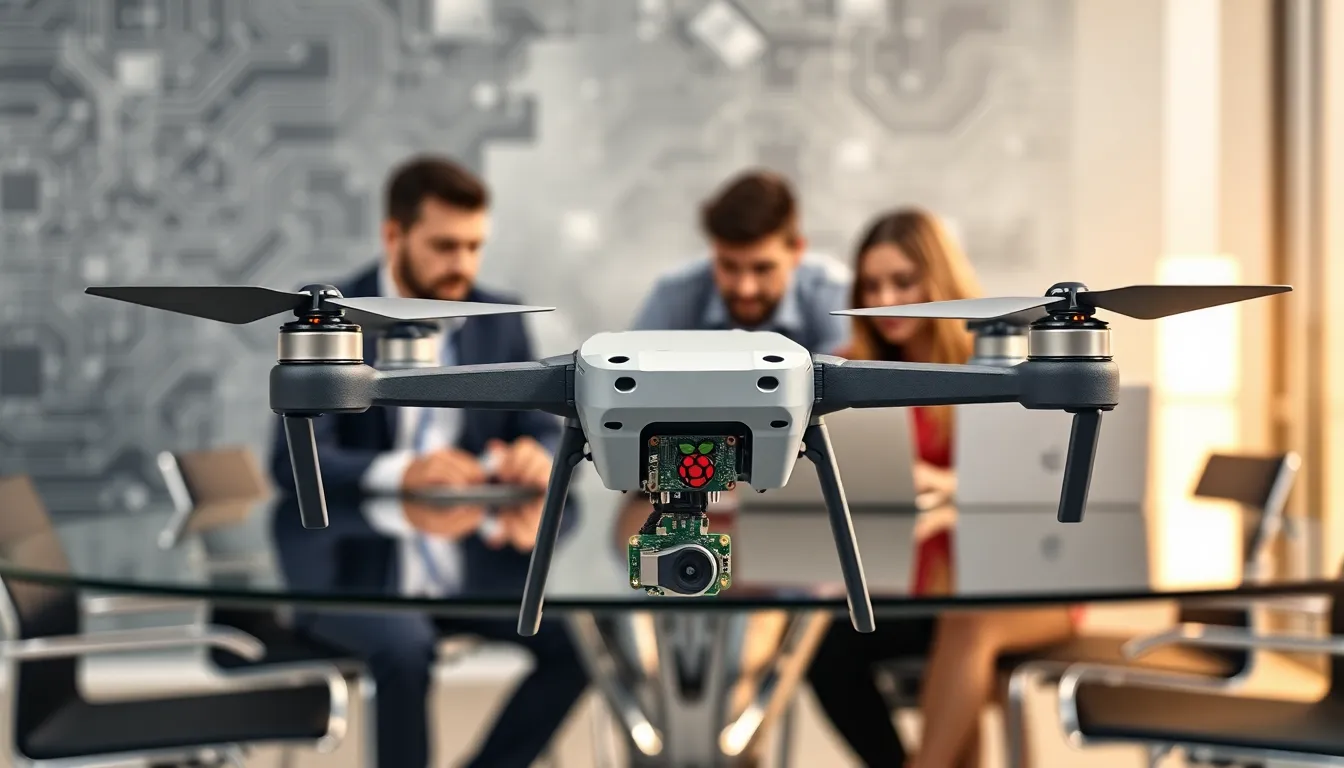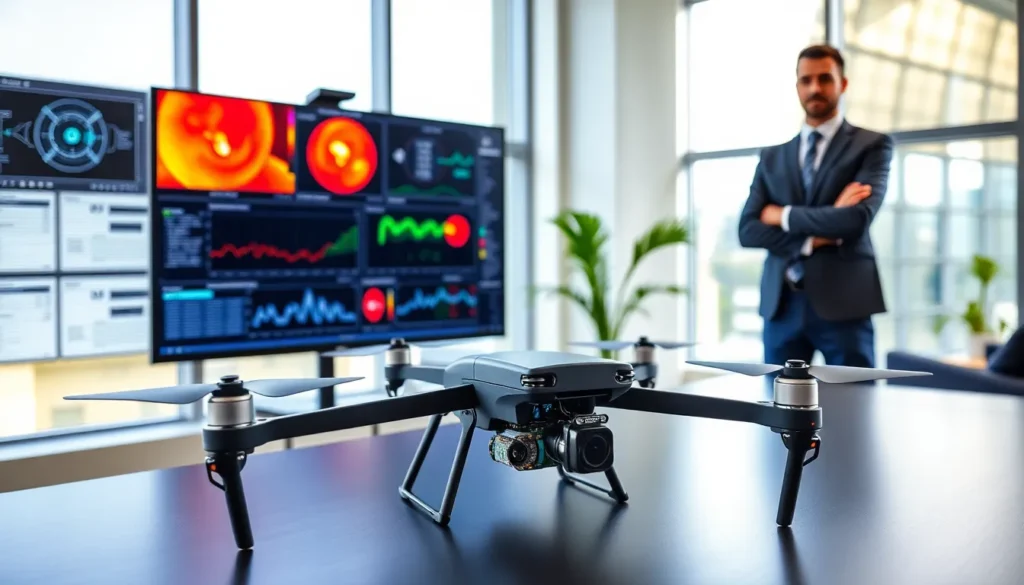Imagine combining the sheer nerdiness of a Raspberry Pi Zero with the sleek, cutting-edge world of thermal drones. It’s not just techy talk: this is where hobby meets high-tech. The Webbizmagnet Raspberry Pi Zero thermal drone might sound like something straight out of a sci-fi movie, but it’s actually a fantastic project for enthusiasts and professionals alike. In this text, you’ll discover how to unlock the full potential of this tiny powerhouse, all while adding a dash of fun and adventure to your flying ambitions.
Table of Contents
ToggleUnderstanding Raspberry Pi Zero

The Raspberry Pi Zero serves as the foundation of this innovative thermal drone. This small yet powerful computer has captured the hearts of tech enthusiasts around the globe. It’s affordable, versatile, and surprisingly capable for its size.
Key Features of Raspberry Pi Zero
The Raspberry Pi Zero boasts a remarkable range of features that make it ideal for drone applications. It weighs less than 10 grams and is incredibly compact, yet it houses a Broadcom BCM2835 CPU, running at speeds up to 1GHz. Coupled with 512MB of RAM, this tiny device can handle substantial computing tasks.
Another key feature lies in its connectivity options. The Pi Zero offers USB On-The-Go, which allows for easy peripherals connection, making it compatible with various sensors and cameras, essential for any thermal drone project. Its GPIO (General Purpose Input/Output) pins allow users to interface with numerous components, providing flexibility in design and functionality.
Applications of Raspberry Pi Zero in Drones
Utilizing the Raspberry Pi Zero within drone technology opens a realm of applications. This small computer can power everything from aerial photography to remote environmental monitoring. For instance, hobbyists can create autonomous flight paths using pre-programmed instructions, while professionals can employ the drone for surveillance, agriculture monitoring, or search and rescue missions. The possibilities are truly vast, demonstrating the Pi Zero’s capability to transform basic flying devices into sophisticated, multi-functional platforms.
Overview of Thermal Imaging Technology
When it comes to drones, thermal imaging technology stands at the forefront of innovation. This technology detects heat emitted by objects, allowing users to see their surroundings in ways previously thought impossible.
Benefits of Thermal Imaging in Drones
The benefits of incorporating thermal imaging into drones are immense. First, it enables superior visibility in low-light conditions. Unlike traditional cameras that struggle at night, thermal imaging effortlessly highlights heat sources, ensuring visibility no matter the time of day.
Also, this technology plays a significant role in enhancing safety measures during various operations, such as fire detection and search missions. For instance, first responders can quickly locate heat signatures in disaster scenarios effectively, saving valuable time and potentially lives in critical situations.
Use Cases for Thermal Drones
Applications of thermal drones are blossoming. Emergency services use these drones to locate victims in disaster-stricken areas more efficiently. Agricultural professionals adopt them for monitoring crop health by identifying heat stress in plants. Similarly, environmental researchers employ thermal drones to study wildlife and track temperatures in habitats without disturbing natural behaviors. The blend of Raspberry Pi Zero and thermal imaging could redefine these practices even further.
Building a Thermal Drone with Raspberry Pi Zero
Constructing a thermal drone using a Raspberry Pi Zero is an enticing project for tech enthusiasts. With the right components and a bit of patience, anyone can take flight.
Essential Components and Hardware Requirements
Before embarking on this journey, gathering the essential components is crucial. You’ll need a Raspberry Pi Zero, a compatible thermal camera (like the FLIR Lepton), a battery (preferably LiPo for balance and power), propellers, a frame to house everything, and flight controllers. Equipping these components ensures your drone not only takes off but also operates smoothly in the air.
Also, don’t forget other tools such as connectors, wires, and a soldering kit. Prior preparation will save time and trouble when the assembly begins.
Step-by-Step Assembly Guide
- Prepare the Frame: Start by assembling the drone frame, ensuring all parts are stable and secure.
- Install the Raspberry Pi Zero: Securely attach the Raspberry Pi Zero to the frame, connecting it to the flight controller.
- Integrate the Camera: Install the thermal camera, connecting it to the Raspberry Pi and ensuring it’s adequately powered.
- Connect the Battery: Safely attach the battery while making sure the weight distribution is balanced to enhance flight stability.
- Conduct Initial Tests: Once assembled, power on the system and perform initial tests to check for any malfunctions or misalignments.
Programming the Thermal Drone
After the hardware assembly, the next step is programming the Raspberry Pi Zero to control the thermal drone.
Choosing the Right Software Tools
Selecting suitable software tools is crucial. The Raspberry Pi community offers a myriad of options such as Python, which is both user-friendly and powerful. Besides, flight control software like ArduPilot can help manage drone operations effectively. Integrating these tools allows users to customize control based on project specific needs.
Basic Programming Concepts for Raspberry Pi
Familiarizing oneself with basic programming concepts is essential for seamless operation. Beginners should understand how to set up the Raspberry Pi’s operating system and manage libraries. Learning how to control GPIO pins and read inputs from the thermal camera will also empower users to extend their drone’s functionality. Also, straightening out issues related to connectivity or data handling can set a robust foundation for more advanced functionalities.
Testing and Calibration of the Drone
Before taking to the skies, thorough testing and calibration are necessary to ensure safe operation of the thermal drone.
Safety Considerations and Regulations
Understanding and adhering to safety regulations is paramount. Users should familiarize themselves with FAA regulations on drone flights, including height limits, no-fly zones, and required registrations. Following these guidelines will ensure responsible flying and limit risks associated with drone operations.
Best Practices for Safe Operation
Best practices include conducting pre-flight inspections, ensuring all components function correctly. It’s wise to carry out test flights in open areas to minimize risks. Besides, constant communication with local authorities when flying in populated zones is advisable, ensuring both legal safety and community awareness.







